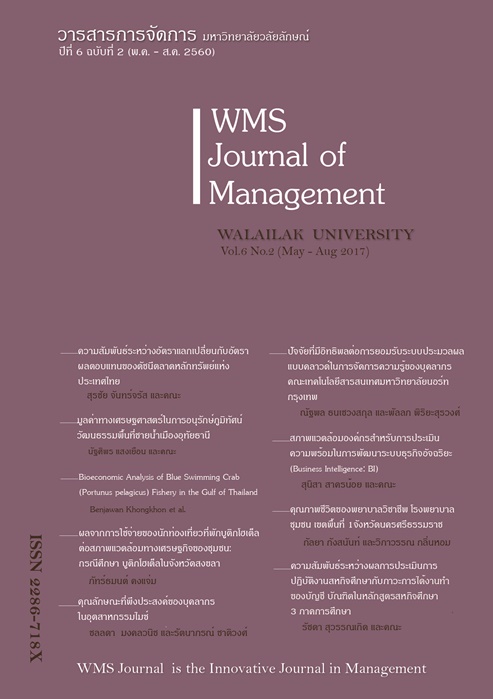Economic Valuation of Cultural Landscape Conservation for Muang Uthai Thani River Edges
Main Article Content
Abstract
The objectives of this study were to assess the economic value of cultural landscape conservation for Muang Uthai Thani River Edges and to propose factors influencing willingness to pay by using the Contingent Valuation Method, and to investigate the sample’s attitudes towards cultural landscape for Muang Uthai Thani River Edges with the Analysis of Variance (ANOVA), which was used to compare the attitudes, satisfaction, and awareness of cultural landscape conservation for Muang Uthai Thani River Edges. Data were collected from 400 local people.
The results showed that for cultural landscape conservation for Muang Uthai Thani River Edges, the 400 samples had willingness to pay at on average 614.41 baht/household/year. Total economic value was 5,503,890.94 baht/year. Factors influencing willingness to pay in positive correlation included education level, monthly income, expense, satisfaction with River Edges, and awareness of cultural landscape conservation but the expense is the factor in the negative correlation. Besides, the sample’s satisfaction with River Edges landscape was at high level (mean= 3.57); the sample’s awareness of cultural landscape conservation was at high level (mean = 3.96). The results of this study could be used as fundamental information to support budget and policy planning for further landscape conservation for Muang Uthai Thani River Edges.Article Details
References
กชพร สุขจิตภิญโญ. 2555. การศึกษาความเต็มใจที่จะจ่ายเพื่อการอนุรักษ์มรดกทางวัฒนธรรม โบราณสถานเวียงกุมกามเชียงใหม่. วิทยานิพนธ์ปริญญามหาบัณฑิต, มหาวิทยาลัยเชียงใหม่.
เกรียงไกร เกิดศิริ. 2551. ชุมชนกับภูมิทัศน์วัฒนธรรม. พิมพ์ครั้งที่ 1. กรุงเทพมหานคร: สำนักพิมพ์อุษาคเนย์.
จรัสทิพย์ สกุลรัตนะพรชัย. 2556. การวิเคราะห์ความเต็มใจที่จะจ่ายและความคุ้มค่าในการป้องกันน้ำท่วม: กรณีศึกษาเขตบางแคกรุงเทพมหานคร. วิทยานิพนธ์ปริญญามหาบัณฑิต, มหาวิทยาลัยเกษตรศาสตร์.
ชนัญ วงษ์วิภาค. 2532. นิเวศวัฒนธรรม. กรุงเทพมหานคร: มหาวิทยาลัยศิลปากร.
รุ้งตะวัน เกิดโภคา. 2553. แนวทางพัฒนาการท่องเที่ยวเชิงนิเวศอย่างยั่งยืนของจังหวัดอุทัยธานี. วิทยานิพนธ์ปริญญามหาบัณฑิต, สถาบันบัณฑิตพัฒนบริหารศาสตร์.
สถาบันวิจัยเพื่อการพัฒนาแห่งประเทศไทย. 2543. คู่มือการศึกษาพัฒนาการวิเคราะห์ผลกระทบสิ่งแวดล้อมด้านเศรษฐศาสตร์สิ่งแวดล้อม. กรุงเทพมหานคร.
สุรพงษ์ โสธนะเสถียร. 2545. หลักและทฤษฎีการวิจัยทางสังคมศาสตร์. พิมพ์ครั้งที่ 2. กรุงเทพมหานคร: โรงพิมพ์ประสิทธิ์ภัณฑ์แอนด์พริ้นติ้ง.
โสมสกาว เพชรานนท์ และ วรวรรณ ตุ้มมงคล. 2555. รายงานฉบับสมบูรณ์การประเมินมูลค่าความเต็มใจจ่ายเพื่อป้องกันน้ำท่วมของประชาชนในกรุงเทพมหานคร. กรุงเทพมหานคร: มหาวิทยาลัยเกษตรศาสตร์.
อมร กฤษณพันธุ์. 2555. สถาปัตยกรรมพื้นถิ่นในบริบทพลวัตภูมิทัศน์วัฒนธรรม: กรณีศึกษา ชุมชนชาวแพ แม่นํ้าสะแกกรัง จ.อุทัยธานี. วารสารวิชาการคณะสถาปัตยกรรมศาสตร์ มหาวิทยาลัยขอนแก่น, 11(1), 1-13.
Consortium Européen sur l’Economie du Paysage. 2009. Landscape Economics. Retrieved February, 22, 2012. From http://www.ceep-europe.org.
Council of Europe. 2000. The European landscape convention. Retrieved October, 2, 2014. From http://www.coe.int/en/web/landscape/about-the-convention.
MA (Millennium Ecosystem Assessment). 2003. Ecosystems and Human Well-Being: A Framework for Assessment. Washington, DC: Island Press.
Matthews, R., and P. Selman. 2006. Landscape as a focus for integrating human and environmental processes. Journal of Agricultural Economics. 57:199-212.
Mitchell, N. and S. Buggy. 2000. Protected landscapes and the cultural landscapes: taking advantage of diverse approaches. The George Wright Forum, 17(1), 35-46.
Price, C. 1978. Landscape Economics. London: Macmillan.
Price, C. 2008. Landscape economics at dawn: An eye-witness account. Landscape Research, 33(3), 263–280.
Rössler, M. 2006. World heritage cultural landscapes: A UNESCO flagship programme 1992-2006. Landscape Research .31(4), 333-353.
Sauer, C. O. 1963. The Morphology of Landscape, in Land and Life: A Selection from the writings of Carl Ortwin Sauer, ed. by J. Leighly. Berkeley: University of California Press.
Van der Horst, D., S. Vermeylen, and E. Kuntashula. 2014. The hedgification of maizescapes? Scalability and multifunctionality of Jatropha curcas hedges in a mixed farming landscape in Zambia. Ecology and Society, 19(2): 48.
von Droste, Bernd, Harald Plachter, and Mechtild Rössler, eds. 1995. Cultural Landscapesof Universal Value. Components of a Global Strategy. Jena, Stuttgart, and New York: Gustav Fischer Verlag, in cooperation with UNESCO.
Yamane, T. 1973. Statistic: An Introductory Analysis. 3 rd. ed. New York: Harper and Row.
Zonneveld, I.S. 1995. Landscape Ecology. Amsterdam: SPB Academic.


